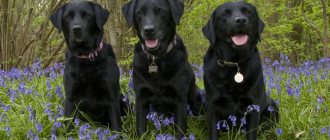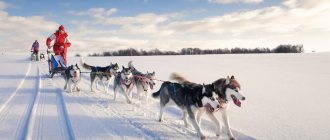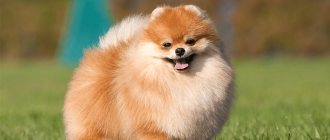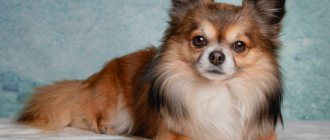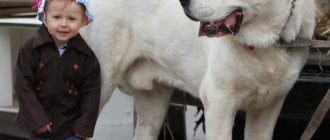There is currently no consensus on where mastiffs originated. A probable theory is that the ancestors of the modern breed were Molossians from Central Asia. The ancient mastiffs of the world were fighting dogs. They took part in baiting wild animals: bears, wild boars, lions. Mastiffs were often used as weapons, because the dog could easily cope with several armed soldiers in a short period of time. Over time, not a trace remained of the animal’s aggression and cruelty. Now he is a completely good-natured and devoted dog, able to understand his owner and make friends with others, including other animals.
Origin story and what it looks like in the photo
The history of the origin of mastiffs is quite ambiguous; it takes roots several centuries BC . The most common version says that the ancestors of the representatives of the majestic breed are Molossian Great Danes from Central Asia.
Dogs were widespread in Europe and Asia and were used as fighting dogs for baiting large wild animals (lions, tigers, bears).
Roman legionnaires used them as living weapons during hostilities, while one dog could cope with two or three armed soldiers.
At the same time, the ancestors of mastiffs were considered excellent guard dogs that protected livestock from attacks by wild animals.
These dogs came to Britain thanks to the Celtic tribes who came from Asia Minor in the 4th-3rd century BC.
It is also noteworthy that the name of the breed comes from the Latin word meaning “dog-horse”, which emphasizes the large size of the dog and its powerful physique..
Description of the breed
Nowadays, when we say "mastiff", we mean the English mastiff with its characteristic features . However, the family includes several more independent species that have a common origin.
All mastiffs are united by their impressive size (some individuals reach a weight of up to 160 kg), strong muscular build, wide mouth and skin dewlap on the neck and abdomen.
There are several more common external characteristics of the mastiff family::
- the average height in the group is from 60 cm, and weight is from 50 kg;
- proportionally built body;
- strong wide body;
- muscular neck of medium length;
- wide head, flat forehead mostly with wrinkles;
- the tail is of medium length, rather thick, lowered when calm.
Among mastiffs there are short-haired representatives with short, close-fitting hair and long-haired ones.
The following species of the family are short-haired::
- English;
- Brazilian;
- bullmastiff;
- Neapolitan;
- French;
- Japanese.
The Tibetan Mastiff has long, thick hair; the Spanish and Pyrenean species have medium-length hair..
brief information
The International Canine Federation officially recognizes 10 types of mastiffs, while there are more than 20 of them in the world. Aboriginal breeds are few in number and cannot boast of a solid history or purity of blood.
Despite some differences in appearance, mastiffs are united by the standard of the breed group:
- Tall height - from 65 cm at the withers, large body weight.
- The head is volumetric-angular, massive in appearance.
- Strong, wide bones, powerful muscles.
- Tucked belly.
- A noticeable supply of “extra” skin, gathered into cozy folds, especially on the head, chest, and neck.
- Pronounced jowls on square jaws.
Small, widely spaced brown eyes, which have known all the wisdom of the world, complement the portrait of a typical mastiff.
Purpose of the breed and maintenance features:
- Life expectancy is 9-14 years .
- Use: friend dog, guard dog, working dog.
- Living space - a private house with a plot. When kept in an apartment, long walks are necessary.
- Physical activity – requires movement, walking at least 2 times.
- The need for communication is high, without the presence of a person, he “withdraws into himself” and shows aggression.
- They grow intensively and need proper nutrition.
- They grow up late, remaining playful teenagers until they are 2-3 years old.
Character traits
Despite its fighting past, the breed is devoid of aggression and anger. Mastiffs are distinguished by their balanced and calm character. Possessing a fearless and formidable appearance, representatives of the family need constant love and care.
Mastiffs get along well with children and other animals, however, most often they are devoted to one owner, so it is not recommended to pass them from hand to hand.
Dogs of this breed are not particularly playful; their character is more like homebodies. At the same time, some individuals can be quite energetic and need constant training and jogging.
Representatives of the breed are intelligent and easy to train.
A big plus is the mastiff's guarding abilities . They treat strangers without aggression, but with caution. If someone tries to harm the owner or his family, the pet is able to prevent this.
Mastiffs are clean dogs, they are not prone to running away from home and will never wander..
Expert opinion
Kozhevin Semyon Kirillovich
Expert dog handler.
“Mastiffs are large, strong and confident dogs, they are independent and unobtrusive. These dogs are excellent guards and will do everything to please their owner. For all its majesty, the mastiff, like a child, needs communication with its owner. Proper socialization and upbringing of a pet from an early age is very important, then it will be careful with children and family friends. Be prepared for the dog to need a lot of space; it is best to have your own area. Equally important in keeping a mastiff is quality care and proper feeding.”
Reviews
Bogdan: “My first dog in my life is a Tibetan mastiff. I was looking for a suitable four-legged dog to guard the house, thought for a long time and finally decided. I don't regret it at all. Her psyche is reinforced concrete, she never reacts to small animals that are always barking. She was never the first to get into a fight. She’s very smart, you don’t need to repeat every day what’s possible and what’s not.”
Alice: “At one time I had an English Mastiff dog, it was the best animal in the world. From puppyhood she was calm and quick-witted and coexisted well with a cat. It was funny to see how kindly Jessie treated her. My daughter was constantly pulling the dog’s ears and throwing a ball, but Jessie just loved it, she was happy to babysit the child.”
Ekaterina: “The whole family fell in love with the Dogue de Bordeaux when we saw it. The decision was immediately made - let's take it! This is the kindest dog in the world, although it seems dangerous and formidable. We have our own home, and Dora does an excellent job of guarding it, doesn’t bark in vain, doesn’t rush at anyone.”
Any mastiff is a wonderful guard and watchman. These are kind, intelligent animals that need affection and care. It doesn’t matter which type is chosen, everything depends only on the owners. How you can raise and train a dog, that’s how it will become.
Advantages and disadvantages
Like any member of the pet class, mastiffs have advantages and disadvantages for those who plan to keep them.
Among the advantages of the breed are the following::
- calm and balanced character;
- fearlessness and excellent security abilities;
- a manifestation of sincere care towards the owner and his family members.
Among the disadvantages, the following can be noted:
- the need for early socialization and a competent approach to education;
- a tendency to demonstrate independence and independence, bordering on stubbornness;
- Quite an expensive dog to keep.
Inexperienced dog breeders, as well as older people, should not own a mastiff of any kind, because raising them requires a certain skill and strength..
What types are there?
The mastiff family is quite large and includes several independent species, divided into separate breeds:
- Tibetan mastiff;
- Neapolitan (Neapolitano);
- English;
- Spanish;
- bullmastiff;
- Pyrenean;
- Pakistani;
- French;
- German;
- Japanese;
- Brazilian;
- major;
- Argentinean;
- American;
- African.
Let's look at the main features of each type.
Tibetan
Perhaps one of the most beautiful and majestic oriental dogs in the world. A distinctive feature is the long coat with a soft undercoat, predominantly black, but there are also red and tan colors.
The Tibetan Mastiff has an impressive appearance - it looks very powerful, but at the same time solemn . The head is massive and strong with almond-shaped eyes and a wide nose.
Tibetans are good guards; they can stay awake at night, protecting their home . They are smart, but independent, they need strict training, but not without understanding and kind attitude from the owner.
You need to start training such a puppy at 3-4 months.
Neapolitano
Sometimes this representative is called the Italian Mastiff. It has an impressive appearance. On the muzzle and in the forehead area, the skin forms characteristic folds. They have short but beautiful fur of black, gray or blue colors.
The Neapolitan has a slender body with strong limbs; its distinctive features are a wide back and a saber-shaped tail..
Like other mastiffs, the Neapolitan is a good watchman and guard, friendly to children, and does not show excessive aggression.
English
They are considered classic representatives of the species and are one of the largest in the family. Short-haired individuals with a dense and soft undercoat have a beautiful color color: apricot, fawn or brindle.
The muzzle has a long shape with pronounced folds of skin, while the width of the head is greater than its length . The English Mastiff has a wide and muscular back and chest, and the overall appearance is powerful and majestic.
Representatives of the species are undoubtedly strong and independent, but they are in dire need of love and care from the owner, and are very attached to him.
They treat children well and can even act as a babysitter . The breed is quite active, but due to its nature, it loves to lie down and be pampered.
Spanish
Spanish Mastiffs are distinguished by a thick, coarse coat with a wide range of colors: apricot, gray, fawn, red, black, brindle, with or without white markings on the paws and chest..
The loose and thick skin of the species hangs around the neck, chest and abdomen.
Loyalty and a caring nature are the hallmarks of the Spanish Mastiff . At the same time, they can be stubborn, requiring a firm hand in education.
Bullmastiff
It is the result of crossing a bulldog and a mastiff. The dog is large and muscular, has a menacing and even frightening appearance to strangers.
The pet has short and smooth fur of various colors, with possible spots on the chest.
This is an ideal pet in all respects. He is loyal, does not try to dominate, and follows given commands.
Quite an agile and fast dog, not phlegmatic like other species.
Iberian
The dog has thick, medium-length hair. A distinctive feature is the color is white or light with dark or marbled spots and a clearly defined mask. The muzzle is narrowed towards the nose, but overall large and wide.
These are very friendly members of the family, have good intelligence and an affectionate character, including towards children..
French
Otherwise it is called Dogue de Bordeaux . The dog has large and strong muscles, and is also quite agile and fast. Sometimes in appearance it is compared to a bulldog.
The Dogue de Bordeaux has a short coat and can be colored in all shades of red . A distinctive feature is the presence of a white spot on the chest.
He is characterized by a calm and serious behavior, he will not bark for no reason. However, to be kept in an apartment with a family, early socialization and strict training are required.
Japanese
Otherwise, this representative of the family is called Tosa-inu . The dog belongs to the Japanese fighting breeds. They have a large and powerful build with a flat back and broad chest. The head is wide and large, there is a characteristic fold on the neck.
The Japanese mastiff is fearless and brave, fighting enemies to the last . There is a streak of stubbornness and independence in his character, but he is normally trainable and listens to his owner.
Brazilian
The Fila Brasileiro has a characteristic dewlap on the neck and belly area, a short, smooth coat of solid yellow or brindle color with possible white markings.
He is called the best security guard in the world, and he is quite stubborn, and even displays a violent character . However, he is immensely devoted to his master and family and is always friendly.
Mayorsky
The second name for mastiffs from the island of the same name in Mallorca is Ca de Bou . They are distinguished by almond-shaped dark eyes and a slightly narrowed muzzle. Their coat is short and coarse with brindle, fawn or black coloring.
Neapolitan Mastiff
The Mastino Neapolitan dog is characterized as a very large, sedentary, melancholic and slightly lazy individual. At the same time, the dog is capable of a lightning-fast attack on the enemy if necessary, and can also protect entrusted property from strangers. The dog will not show aggression towards a stranger until he begins to attack. The pet will show normal attention to others if they are not within the family's own territory. If strangers have entered the dog's domain, he will not let them out of his sight until they leave.
The breed has a strong build and well-developed muscles. There are a large number of folds on the body. In fact, this is how nature intended it - thanks to the considerable amount of loose skin, Neapolitan Mastiffs are well protected from injury. Indeed, in ancient times, these dogs fought in bloody battles and took part in baiting wild animals.
Males are slightly larger than females in size. So, an adult dog reaches 70-75 cm at the withers and weighs 60-70 kg. Females grow up to 60-68 cm and 55-60 kg, respectively. The body is strong and slightly elongated. The neck is powerful, curved, with two dewlaps made of deep folds. The chest is wide, voluminous, arched. The limbs are thick and muscular. The fingers are gathered into a tight, dense ball. The tail is set low and strong. Wide at the base, it tapers towards the tip. Can be docked at 2/3 of the original length.
The large head is quite proportional to the dog's body. The forehead is flat, the separation from the muzzle reaches almost 90°. The furrow between the muzzle and forehead is emphasized by folds. The skin hangs down on your pet's forehead, cheeks and neck. The lips are fleshy and drooping. There is a red line running inside. The eyelids hang over the eye sockets and completely cover them. The conjunctiva is also red. The eyes are set low and deep. This allows the dog to control its prey despite the heavy bleeding. The iris of the eyes can have different colors - from light to dark (preferably to match the coat).
The jaws are quite powerful, with a pincer or scissor bite. The grip is tearing. The teeth are complete, the incisors are necessarily straight. This type of mastiff breed has an intelligent, phlegmatic and calm gaze. But when irritated and dissatisfied, the dog’s gaze will clearly indicate its internal state.
Color variations
In general, the family has a wide range of coat colors.
The main shades are:
- deer;
- apricot;
- black and tan;
- grey;
- brindle;
- ginger;
- white with spots.
Apricot and fawn colors are characteristic of English mastiffs, but a mandatory condition for them is the presence of a black mask on the face.
Bullmastiffs also have a dark mask, with the rest of the body being a solid color . Any shades of brindle, fawn or red are allowed
Gray, lead gray and black colors are characteristic of the Neapolitan. Black coloring and red or other tan colors can be seen in Tibetan Mastiffs.
Pyrenean Mastiffs are primarily white with black markings . The fawn color is characteristic of Spanish Mastiffs.
The blue shade of Neapolitan is considered quite original. Also available in mahogany and isabella colors.
Nutritional Features
Basically, only wealthy dog breeders can boast of keeping a mastiff.
After all, pets of this breed require a special diet . Given the dog's rapid growth and the need for protein food, feeding can be quite expensive, especially if it is feeding a Tibetan Mastiff.
However, a proper diet is extremely important to ensure the health and lifespan of your mastiff . In this case, it is necessary to maintain proportions so as not to cause obesity in the dog.
The total amount of food per day for an adult dog is calculated at the rate of 60 grams per 1 kilogram of the dog’s weight.
Let's highlight the basic rules of mastiff nutrition:
- protein foods should make up 50-60% of the diet (meat, fish, offal);
- it is important to give your pet fermented milk products, including cottage cheese, every day;
- Be sure to eat vegetables (zucchini, pumpkin, carrots);
- It is best to offer your pet porridge made from buckwheat or rice;
- When feeding naturally, be sure to give vitamin supplements along with food.
IMPORTANT!
The food offered to a mastiff must first of all be balanced; it is best to give preference to good quality dry food intended for large breeds of dogs.
Health and major diseases, life expectancy
Mastiff dogs have fairly good health, are unpretentious in food and adapt well to external conditions, and are not afraid of cold or heat. Representatives of the breed are practically not susceptible to diseases and live on average up to 15 years.
But, like any living beings, mastiffs have weaknesses, they are characterized by the following diseases:
- hip dysplasia;
- diseases of the musculoskeletal system;
- eye diseases: cataracts, glaucoma, entropion, retinal atrophy;
- ear mite;
- obesity;
- skin diseases;
- infectious diseases.
Each type of mastiff has its own average life expectancy, let's present the data in the form of a table:
| View | Life expectancy (years) |
| English | 10-12 |
| Brazilian | 12-15 |
| Bullmastiff | 8-10 |
| Spanish | 10 |
| Neapolitan | 7-9 |
| Iberian | 10-15 |
| Tibetan | 10-14 |
| French | 8-10 |
| Japanese | 10-12 |
Mating
Depending on the pedigree of the dog, mating can be either regular or breeding. If pedigree documents have been created for animals, then mating must be carried out on an official basis. The girl's owners must request a special certificate from the nursery and find a mating cable. The time and date of mating should be discussed in advance.
Mating is carried out only after the female mastiff reaches the age of 2 years.
- At 8-10 months, the first heat will begin, but at this period she is too weak to bear puppies. The process itself should be planned for the 15th day of the third heat period, when the girl begins to have light and bloody discharge and the loop swells.
- Mating this breed requires a lot of space, so the space where the process will take place should be prepared in advance. To get to know each other, you can take your pets out for a walk together so that they can get to know each other and sniff each other.
- When the mastiff boy mounts, you should help the animals continue mating.
- The girl is supported under the stomach and by the head, and the cable is directed into the loop. This is done to ensure that the animals are not injured in the process.
- The lock together with sexual intercourse lasts about 20 minutes .
- The next mating should be repeated after 2 days .
Features of care
Mastiffs are not long-lived, the average life expectancy according to statistics is 7-10 years, in order to improve the quality of life and maintain the health of the pet, it is necessary to take into account the peculiarities of the care and maintenance of mastiffs:
- a large and powerful pet living in an apartment requires constant physical activity;
- The dog's fur must be combed daily;
- perform constant water procedures as needed using a special shampoo;
- it is important to monitor the condition of your eyes and ears;
- try to trim your pet’s claws in a timely manner;
- Provide your dog with constant access to clean water.
Tips for choosing a puppy
How to choose a puppy? Choosing an Italian Mastiff in Russia is difficult, since there are only three kennels officially involved in breeding Neapolitan Mastiffs. Only there are all the conditions created for the free development of puppies: there are large, bright rooms, premium food and clean water are freely available. The health of the bitch and the babies is monitored by veterinarians who carry out vaccinations during the course.
First you need to meet the parents of the Neapolitan Mastiff and check the authenticity of the documents. Then, having convinced themselves of the adequacy of the adult dogs, they pay attention to the puppy: he should be active and moderately friendly. When meeting the baby for the first time, he shows keen interest.
When examining Neapolitan Mastiff puppies, pay attention to the condition of the mucous membranes, the color of the skin on the stomach, and the condition of the paws. If the buyer cannot make a choice on his own, you can use the breeder’s consultation (it is either included in the price of the puppy, or its price is low).
Weight and dimensions of the main types
The breed diversity of mastiffs, represented by several species, is distinguished by its large size and impressive body weight.
However, there are slight differences in the sizes of several individual species, reflected in the following table:
| Names of Mastiff varieties | Weight, kg) | Height (cm) |
| English | from 70 | from 75 |
| Brazilian | 40-50 | 65-75 |
| Bullmastiff | 50-60 | 60-70 |
| Spanish | 80-85 | from 70 |
| Neapolitano | 50-70 | 60-75 |
| Tibetan | 55-75 | 70-75 |
| French | from 50 | from 60 |
| Japanese | from 40 | from 55 |
The English mastiff Aikama Zorba from Great Britain became famous for its record size in 1989 . His weight was 156 kg with a height at the withers of 94 cm.
Of the living dogs, the record holder is the Tibetan mastiff Hong Dong, whose weight is 113 kg.
Mentions of Mastino Neapolitan
Movies
In the Harry Potter films, Hagrid's dog, Fang, was played by Mastino Neapolitan.
Famous representatives of the breed: myths and reality
There is very widespread information on the Internet about the Neapolitan mastiff Hercules, which was listed in the Guinness Book of Records as the largest dog weighing 128 kg. True, such a record could not be found on The Guinness World Records website, and some sources also claim that the photo of the dog is fake, since the size of the dog in the photo is slightly smaller than the size of a horse.
Neapolitan Mastiff
But the dog Hercules really existed, only he was an English mastiff whose owner was named John Flynn from Peabody, Massachusetts. And the dog's weight was 282 pounds (128 kg).
English Mastiff Hercules
There is a record of Mastino as the largest puppies, it dates back to 2004, and the babies were born in England.



